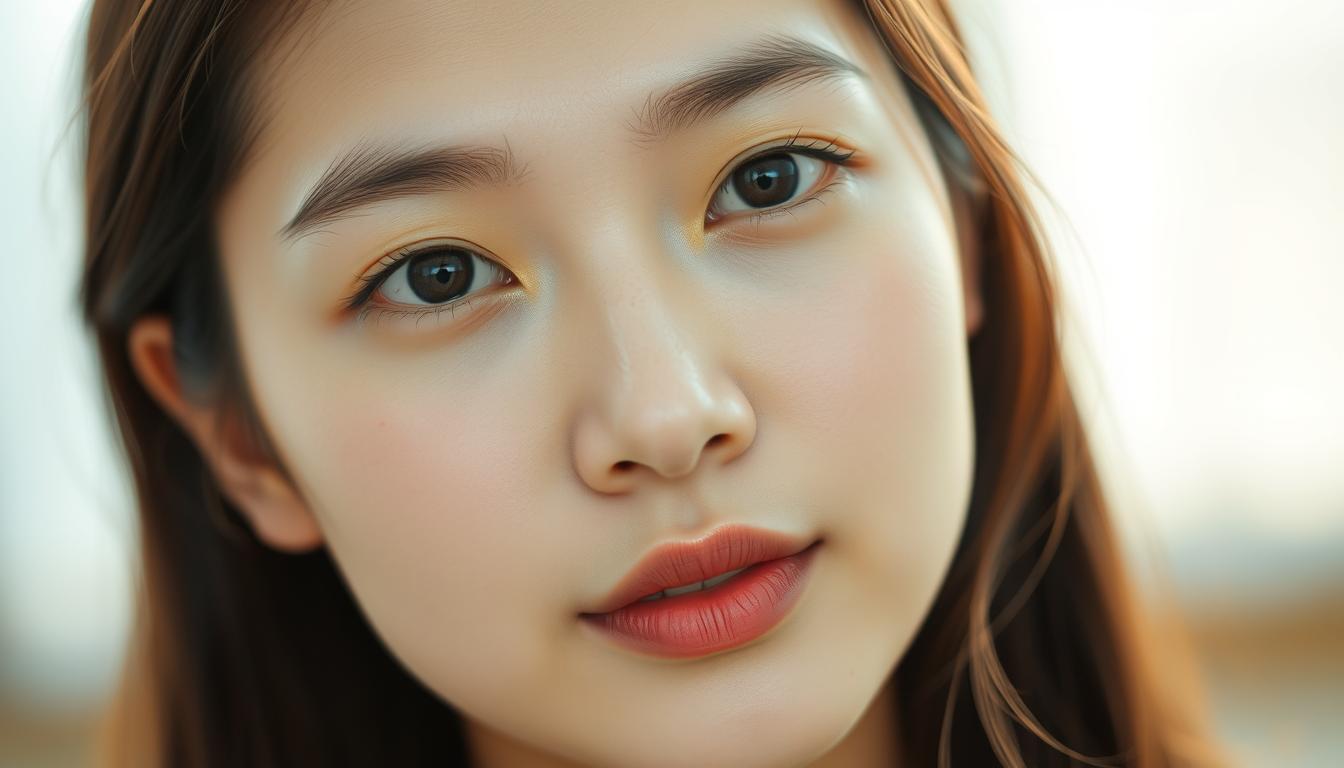In South Korea, the concept of beauty is deeply ingrained in the culture, with a significant emphasis on physical appearance. A key aspect of this beauty standard is the face, where a slightly smaller face in proportion to the body is considered a sign of beauty. The measurement from the hairline down to the tip of the chin is used to determine facial size, with a measurement less than 19 cm (7.5 inches) being considered a small face.
The significance of facial appearance extends beyond physical beauty to encompass social standing and cultural identity. Korean beauty standards have evolved to create distinctive ideals that influence cosmetic procedures and treatments throughout Asia and increasingly worldwide.
Key Takeaways
- The concept of “face” in Korea is closely tied to social standing and cultural identity.
- Korean beauty standards have a significant influence on cosmetic procedures and treatments.
- South Korea is a global leader in cosmetic surgery and facial treatments.
- Understanding Korean beauty standards is crucial for those considering facial treatments or surgery.
- The cultural significance of face in Korea provides valuable context for medical tourists.
Understanding the Cultural Significance of “Face” in Korea
In Korean culture, the concept of “face” plays a crucial role in shaping individual and societal behaviors. The term “chemyeon,” which translates to “face” or “social dignity,” is a complex concept that encompasses the social status, reputation, and prestige an individual or family holds within their community.
The Concept of “Chemyeon” in Korean Society
The concept of chemyeon is deeply rooted in Confucian values, emphasizing the importance of social harmony and respect for hierarchy. Maintaining chemyeon is crucial in Korean society, as losing it can lead to social exclusion and loss of reputation. For instance, Lee Jung-ah, 36, ended her relationship due to her parents’ disapproval, fearing they would lose face among their relatives and acquaintances.
How “Face” Influences Personal and Social Decisions
The fear of “losing face” drives many personal decisions in Korean society. Koreans often evaluate potential life partners based on how the match will affect their family’s social standing. Consumer behavior is also influenced by chemyeon, with many South Koreans purchasing luxury goods to maintain social status. This cultural phenomenon explains why they are among the world’s highest per-capita spenders on luxury goods and cosmetic procedures, seeing these as investments in social capital.
The pressure to maintain face extends to professional settings, where appearances and credentials often take precedence over practical considerations. As a result, individuals may prioritize maintaining their face over personal happiness or well-being, to avoid being judged by others.
Korean Beauty Standards: What Makes a “Perfect Face”
The Korean beauty industry is driven by a precise definition of what constitutes a perfect face. This ideal is characterized by specific facial features and proportions that are highly valued in Korean culture.
The Ideal Face Size and Proportions
In Korean beauty standards, the ideal face is often described as having a harmonious balance of features. Facial symmetry is highly prized, with a slightly smaller right side of the face considered more aesthetically pleasing. The overall face size is also a consideration, with a smaller, oval-shaped face generally regarded as more attractive.

The proportions of the face are crucial, with a focus on achieving a smooth, curved jawline and a well-defined chin. These features contribute to a refined and elegant appearance that is highly valued in Korean beauty culture.
Desired Facial Features in Korean Beauty Culture
Korean beauty standards place a significant emphasis on specific facial features. For instance, eyes with double eyelids (쌍꺼풀/ssangkkeopul) are highly prized for their appearance of being larger and more expressive. The ideal nose has a straight, high bridge with a slightly elevated tip, creating a refined profile.
Additionally, a smooth, luminous complexion is paramount, with the “glass skin” ideal being a hallmark of Korean beauty. Lips should be naturally full with a clearly defined cupid’s bow, contributing to a youthful appearance. A well-defined chin is also considered essential for a balanced facial structure.
These desired facial features collectively contribute to the Korean ideal of a perfect face, influencing both personal beauty routines and the popularity of certain cosmetic procedures among those seeking to enhance their faces in line with Korean beauty standards.
The Evolution of Korean Beauty Standards
The evolution of Korean beauty standards is a complex process, driven by historical, cultural, and modern societal factors. This transformation reflects the dynamic interplay between traditional values and contemporary influences, shaping the modern concept of beauty in Korea.
Historical Influences on Korean Beauty Ideals
Historical influences have played a significant role in shaping Korean beauty ideals. Traditional Korean beauty standards were characterized by a preference for a fair complexion, which symbolized nobility and wealth. The influence of Confucianism also emphasized modesty and restraint in appearance. These historical elements continue to impact contemporary beauty standards, with many Koreans still valuing a clear and smooth complexion.
During the Joseon Dynasty, beauty standards were heavily influenced by the aristocracy, with a focus on elegance and refinement. The use of makeup and skincare was prevalent among the upper classes, setting a precedent for the importance of beauty rituals in Korean culture.
Modern Influences: K-Pop, Media, and Global Impact
In recent years, Korean beauty standards have been significantly influenced by modern factors such as K-Pop and social media. The rise of K-Pop in the late 1990s and early 2000s created new beauty icons whose carefully crafted appearances have shaped contemporary Korean beauty standards. Social media platforms have accelerated the standardization of these ideals, creating specific templates for the “perfect” face.
The global influence of Korean beauty standards is evident in the Hallyu (Korean Wave) phenomenon, where international fans seek to emulate the looks of their favorite Korean celebrities. This has led to a fusion of Eastern and Western beauty ideals, resulting in distinctive features that are now recognized and emulated worldwide. The modern Korean entertainment industry has created a feedback loop where celebrities undergo specific procedures to meet beauty standards, further reinforcing those standards for the public.
Popular Facial Cosmetic Procedures in South Korea
South Korea is renowned for its advanced facial cosmetic surgery techniques, drawing patients from around the world. The country’s cosmetic surgery industry has evolved to cater to a wide range of facial procedures, each designed to achieve specific beauty standards.
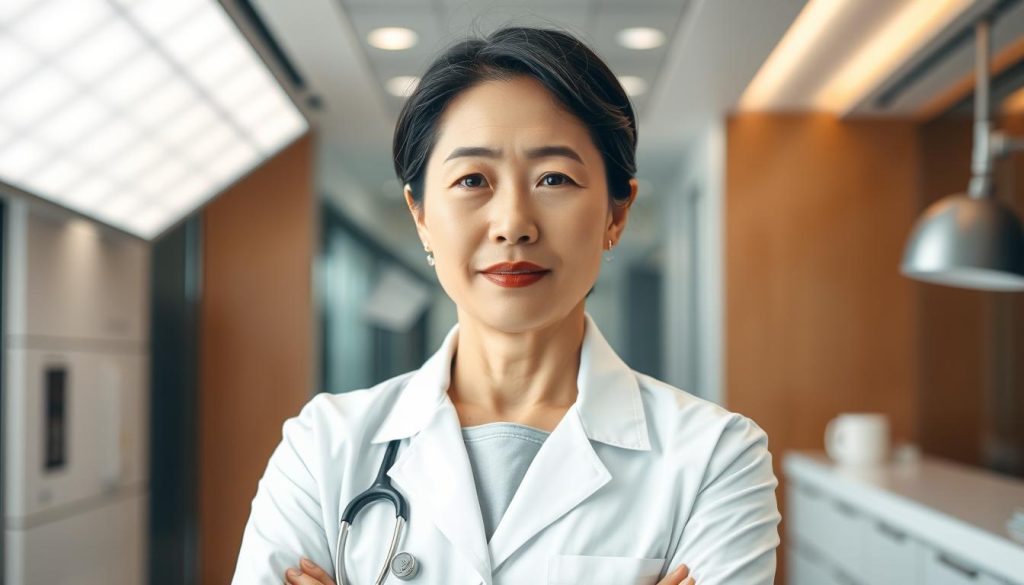
Eyelid Surgery (Double Eyelid) Procedures
Eyelid surgery, commonly known as double eyelid surgery, is one of the most popular cosmetic procedures in South Korea. This surgery involves creating a crease in the upper eyelid to give the appearance of larger, more rounded eyes. The procedure is highly customizable, allowing patients to choose the shape and size of their desired eyelid crease.
Nose Reshaping Techniques
Nose reshaping, or rhinoplasty, is another sought-after procedure in South Korea. Korean surgeons employ advanced techniques to enhance the shape and size of the nose, often using implants or cartilage grafts. The goal is to create a nose that is in harmony with the other facial features, enhancing overall facial aesthetics.
Jaw and Chin Contouring Options
Jaw and chin contouring procedures are highly popular in Korea, where a slim, V-shaped face is considered a beauty ideal. V-line surgery reshapes a square jawline into a slender V-shape through bone reduction and contouring. Additionally, mandible angle reduction reduces the width of the lower face by shaving the outer corners of the jaw, creating a more oval or heart-shaped facial contour. Genioplasty, or chin reshaping, typically focuses on creating a more pointed, delicate chin that completes the V-shaped face ideal.
These facial contouring procedures have become signature elements of Korean cosmetic surgery, with techniques that minimize nerve damage and recovery time. The combination of jaw reduction and chin reshaping can dramatically alter facial proportions, achieving the small, V-shaped face that represents the pinnacle of Korean beauty standards.
Non-Surgical Facial Treatments in Korea
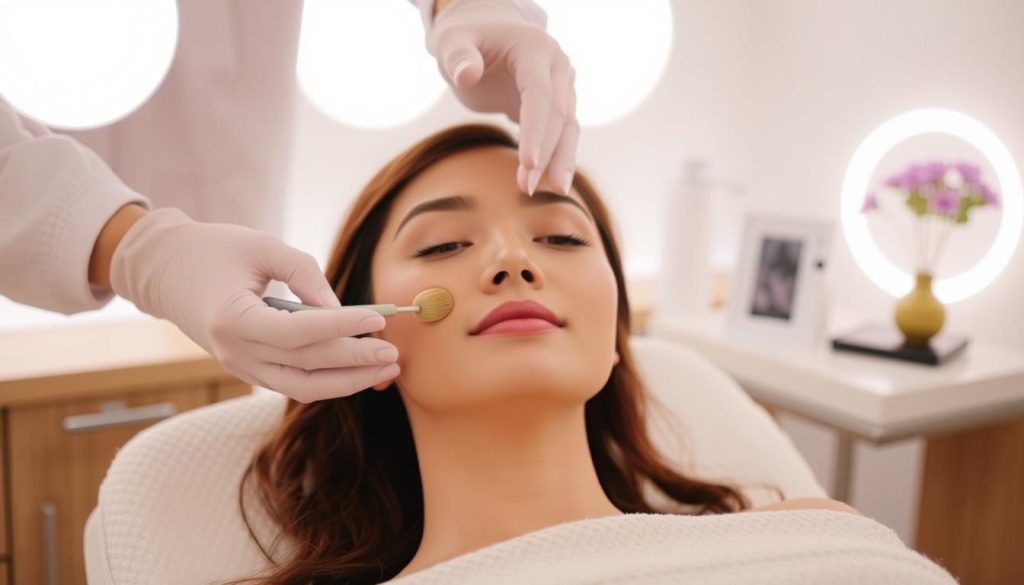
The Korean aesthetic industry is renowned for its cutting-edge non-surgical facial treatments, offering a range of options for various concerns. These treatments have gained popularity globally due to their effectiveness and minimal downtime.
Advanced Skincare Treatments and Technologies
Korea is at the forefront of advanced skincare treatments, incorporating the latest technologies to address various skin concerns. Innovative treatments include “Skin Botox” or “meso-Botox,” a technique that involves injecting diluted Botox into the skin’s superficial layers to achieve a glass-skin effect by reducing pore size and oil production.
Fillers, Botox, and Thread Lifts: The Korean Approach
Korean practitioners have developed unique approaches to non-surgical facial rejuvenation. They use micro-dosing techniques for Botox and fillers, creating subtle enhancements that appear natural. Thread lifting procedures, popularized in Korea, include specialized techniques like the “mesh lift” and “sandwich lift,” providing dramatic results with minimal downtime. Fillers are often used for facial contouring, strategically placed to create the appearance of a smaller, more V-shaped face without plastic surgery.
Combination protocols using Botox, fillers, and threads in a single session are common in South Korea, reflecting a holistic approach to facial rejuvenation. This integrated method allows practitioners to address multiple concerns simultaneously, achieving comprehensive results.
How to Research Face in Korea Cosmetic Surgery Clinics
To ensure a successful cosmetic surgery experience in Korea, researching the clinic is crucial. With numerous clinics offering a wide range of services, it’s essential to know what to look for.
Evaluating Clinic Credentials and Reputation
When evaluating a clinic, start by examining its credentials and reputation. Look for clinics with board-certified surgeons and accreditations from reputable organizations. A clinic’s reputation can be gauged through online reviews and testimonials from previous patients. Ensure the clinic has experience with the specific procedure you’re interested in, such as plastic surgery or facial procedures.
| Credential | Description | Importance |
|---|---|---|
| Board Certification | Surgeons certified by a recognized board | High |
| Clinic Accreditation | Accreditation from a reputable health organization | High |
| Patient Reviews | Feedback from previous patients | Medium |
Reading Reviews and Before/After Results
Reading reviews from multiple sources can provide insights into a clinic’s strengths and weaknesses. Additionally, reviewing before-and-after photos of previous patients can help you understand the surgeon’s skill level and the potential outcomes of your procedure. Pay particular attention to results for patients with similar facial structures or concerns.
Questions to Ask During Consultations
During your consultation, ask detailed questions to ensure you’re making an informed decision. Inquire about the surgeon’s experience with your desired procedure, including the number of procedures they perform monthly and their specialized training. Discuss potential complications, recovery timelines, and post-operative care to understand what to expect. It’s also crucial to ask about the techniques used and whether they offer personalized recommendations or a one-size-fits-all approach.
- Ask about the surgeon’s specific experience and training.
- Request before/after photos of similar patients.
- Discuss available options and potential complications.
By thoroughly researching a clinic and asking the right questions, you can make an informed decision about your cosmetic surgery in South Korea.
Preparing for Cosmetic Procedures in South Korea
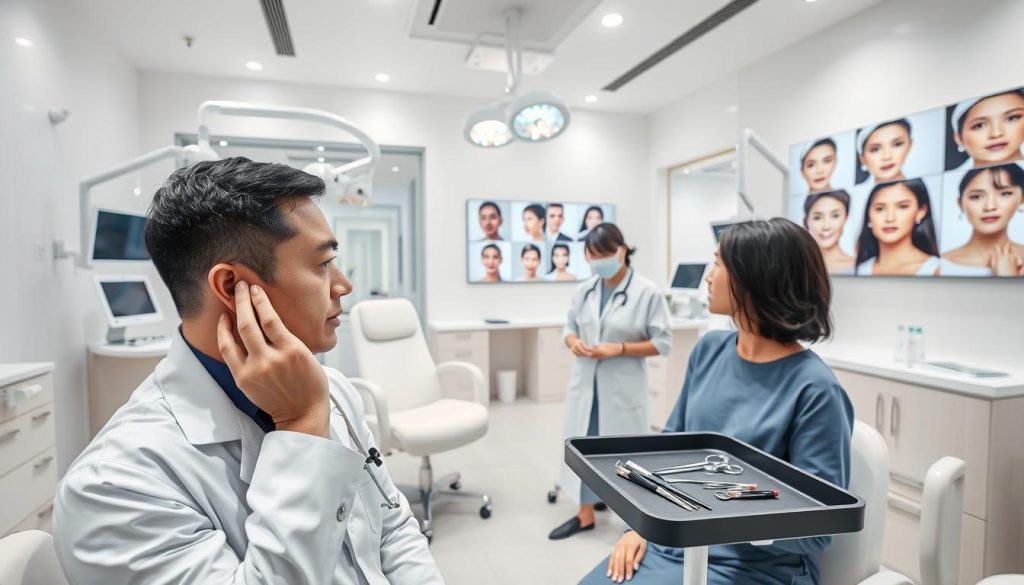
A successful cosmetic surgery experience in South Korea begins with thorough preparation and planning. As a popular destination for medical tourism, South Korea offers advanced cosmetic procedures, but patients must be prepared to navigate the process effectively.
Medical Tourism Planning: Visa, Accommodation, and Translation Services
When planning to undergo cosmetic procedures in South Korea, several logistical considerations must be taken into account. This includes arranging for a visa, booking accommodation, and potentially securing translation services to facilitate communication with medical staff.
- Research visa requirements and application processes for your country.
- Book accommodation that suits your recovery needs, potentially near your clinic.
- Consider hiring a medical tourism agency or translation service to assist with language barriers.
Pre-Procedure Health Considerations and Requirements
Before undergoing cosmetic surgery in South Korea, it’s crucial to address pre-procedure health considerations. This includes completing required pre-operative testing, adjusting medications as directed by your physicians, and understanding the clinic’s pre-operative protocols.
- Complete all required pre-operative testing before traveling to South Korea.
- Adjust medications as directed by both your home physician and Korean surgeon.
- Understand and comply with the clinic’s pre-operative protocols, which may differ from those in your home country.
By carefully planning and preparing for your cosmetic procedure in South Korea, you can ensure a smoother and more successful experience.
The Recovery Process After Korean Facial Procedures
Resting your face after Korean facial procedures is crucial, and clinics provide detailed guidance on the recovery process. The comprehensive care offered by Korean clinics ensures that patients achieve the best possible results from their facial surgery or treatments.
Typical Recovery Timelines for Different Procedures
Recovery timelines can vary significantly depending on the type of facial procedure undertaken. For instance, eyelid surgery may require a shorter recovery period compared to more complex surgeries like jaw contouring. Generally, patients can expect the initial healing phase to last around 1-2 weeks, with full recovery taking several months.
| Procedure | Initial Recovery | Full Recovery |
|---|---|---|
| Eyelid Surgery | 5-7 days | 1-2 months |
| Nose Reshaping | 7-10 days | 2-3 months |
| Jaw Contouring | 10-14 days | 3-6 months |
Post-Procedure Care and Follow-up Appointments
Korean clinics are known for their meticulous post-operative care. This includes specialized treatments such as Intense Pulsed Light (IPL) therapy to reduce bruising, hyperbaric oxygen treatments to accelerate healing, and LED therapy to minimize scarring. Detailed wound care instructions are also provided, with specific cleansing solutions, ointments, and dressing changes scheduled at precise intervals.
Follow-up appointments are typically scheduled at specific milestones: 1 day post-op for initial assessment, 5-7 days for suture removal, 14 days for evaluation of early healing, and 1, 3, and 6 months for long-term result assessment. For international patients, virtual follow-up consultations are often offered after returning home, providing guidance on when to resume normal activities, sun exposure, and skincare routines.
Understanding the Costs of Korean Facial Treatments
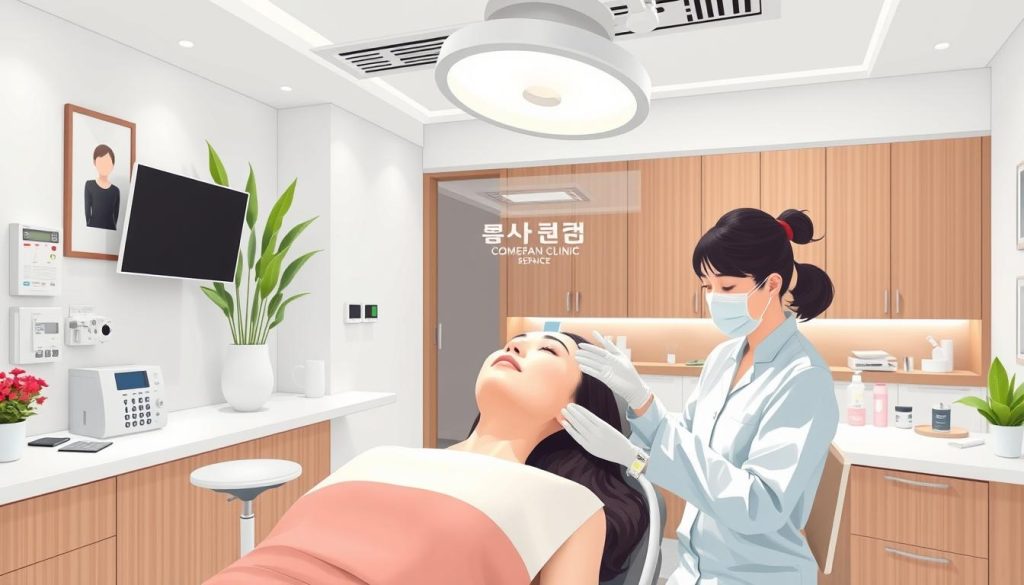
Understanding the financial aspects of cosmetic surgery in South Korea is crucial for making informed decisions. The cost of facial treatments in Korea can vary widely based on factors such as the type of procedure, the clinic’s reputation, and the surgeon’s expertise.
Price Ranges for Popular Procedures
The costs of popular cosmetic procedures in South Korea can range significantly. For instance, eyelid surgery can cost between $1,000 to $3,000, while nose reshaping may range from $2,000 to $5,000. Jaw and chin contouring procedures can cost anywhere from $1,500 to $4,000. It’s essential to research and compare prices among different clinics to find the best value for your money.
Insurance, Payment Options, and Hidden Costs
Medical insurance typically does not cover cosmetic procedures in South Korea. However, some clinics offer financing options or payment plans for both domestic and international patients. It’s crucial to budget carefully for additional costs beyond the procedure itself, including consultation fees, medication expenses, post-operative care supplies, and specialized garments. International patients should also consider accommodation costs in Seoul, which can average $100-$200 per night, transportation, and translation services, which can cost $50-$100 per hour.
Many Korean clinics require cash payments or wire transfers rather than credit cards, with deposits of 10-30% typically required to secure surgery dates. Additionally, foreign patients may be eligible for a tax refund on the 10% Value Added Tax (VAT) when departing South Korea, provided they have the proper documentation from the clinic.
Potential Risks and Considerations
Korean cosmetic surgery and treatments have become increasingly popular, but it’s vital to be aware of the potential risks and complications. While many individuals have successful experiences, others may encounter unforeseen issues.
Medical and Aesthetic Risks to Be Aware Of
Cosmetic procedures, whether surgical or non-surgical, carry inherent risks. These can include infection, scarring, and adverse reactions to anesthesia or materials used in treatments. It’s essential to thoroughly research and understand these risks before making a decision. According to experts, some patients may experience unforeseen complications, such as asymmetry or undesirable outcomes, which can be challenging to correct.
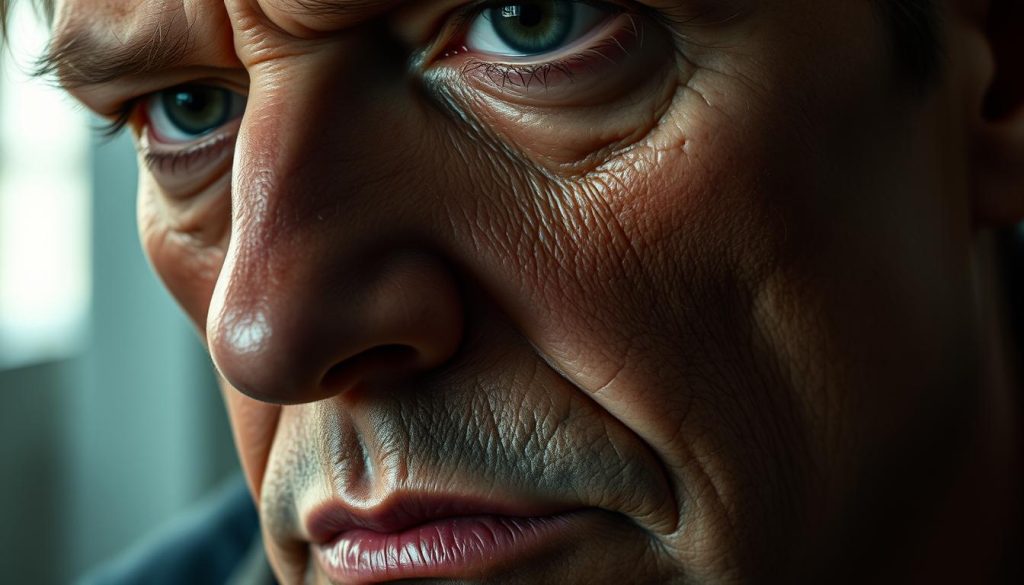
Cultural and Psychological Aspects of Changing Your Appearance
Changing one’s face or appearance can have profound psychological effects. As noted by Han Seong-yeul, an emeritus professor of psychology at Korea University, “Koreans assess a person’s success or failure based on how important they look on the surface, rather than their inner side.” This cultural emphasis on appearance can lead to significant psychological impacts, both positive and negative.
- The psychological impact of dramatically changing your appearance can be profound, potentially leading to identity dissociation or difficulty adjusting to the new look.
- Cultural differences in beauty standards may create challenges when returning to your home country, as features considered beautiful in Korea might be perceived differently elsewhere.
- Family and social reactions to facial changes can be unpredictable, with some individuals facing criticism or questioning about their decision.
In society, where beauty standards are high, some individuals may feel pressure to continually enhance their appearance, potentially leading to a cycle of repeated procedures. If not managed carefully, this can result in significant financial strain and potential psychological dependency on maintenance treatments, potentially causing a person to worry they would lose their enhanced look.
Embracing the Korean Approach to Facial Beauty
The concept of “face” in Korea extends far beyond physical appearance, influencing personal and social decisions in profound ways. As Korea University professor Han noted, the cultural significance of “chemyeon” has played a crucial role in the country’s rapid development, driven by the desire to be respected and ensure a better life for future generations.
The Korean approach to facial beauty represents a unique philosophy that balances artistic vision with technical precision. By emphasizing prevention and maintenance, Korean beauty culture recommends a combination of subtle procedures, advanced skincare, and lifestyle modifications for optimal results. This holistic approach addresses multiple aspects of facial aging simultaneously, creating more comprehensive and natural-looking rejuvenation.
While Korean beauty standards have specific ideals, the best practitioners adapt these principles to each patient’s unique facial structure and ethnic background. Understanding and selectively adopting elements of the Korean approach can provide valuable insights for patients worldwide, enhancing their own beauty routines and treatments.
FAQ
What is the significance of "face" in Korean culture?
The concept of “face” is deeply rooted in Korean society, where it is known as “chemyeon.” It refers to the social image or reputation a person maintains, and it plays a crucial role in personal and professional relationships.
What are the ideal facial features in Korean beauty standards?
Korean beauty ideals emphasize a smooth, fair complexion, a small nose, double eyelids, and a V-shaped jawline. These features are often associated with beauty and elegance.
Why is plastic surgery so prevalent in South Korea?
South Korea has one of the highest rates of plastic surgery per capita in the world. The cultural pressure to conform to certain beauty standards, combined with the country’s advanced medical technology and competitive societal environment, contributes to its prevalence.
What are some popular facial cosmetic procedures in South Korea?
Popular procedures include eyelid surgery (double eyelid), nose reshaping, jaw and chin contouring, and facial contouring. These procedures aim to enhance facial features and achieve a more balanced, aesthetically pleasing appearance.
How do I research reputable cosmetic surgery clinics in South Korea?
To find a reputable clinic, evaluate their credentials, read reviews, and examine before-and-after results. It’s also essential to ask questions during consultations, such as the qualifications of the surgeons and the clinic’s safety record.
What should I consider when preparing for cosmetic procedures in South Korea?
When planning medical tourism, consider visa requirements, accommodation, and translation services. Additionally, be aware of pre-procedure health considerations and requirements, such as medical tests or consultations.
What is the typical recovery process after facial procedures in South Korea?
Recovery timelines vary depending on the procedure. Generally, patients can expect some swelling, bruising, or discomfort. Post-procedure care and follow-up appointments are crucial for a smooth recovery.
How much do Korean facial treatments cost?
The cost of facial treatments in South Korea varies widely depending on the procedure, clinic, and location. Researching price ranges and understanding insurance, payment options, and potential hidden costs can help you plan.
What are the potential risks and considerations of changing my appearance through cosmetic surgery?
As with any medical procedure, there are medical and aesthetic risks to be aware of. Additionally, consider the cultural and psychological aspects of altering your appearance, as it can impact your self-perception and social interactions.
